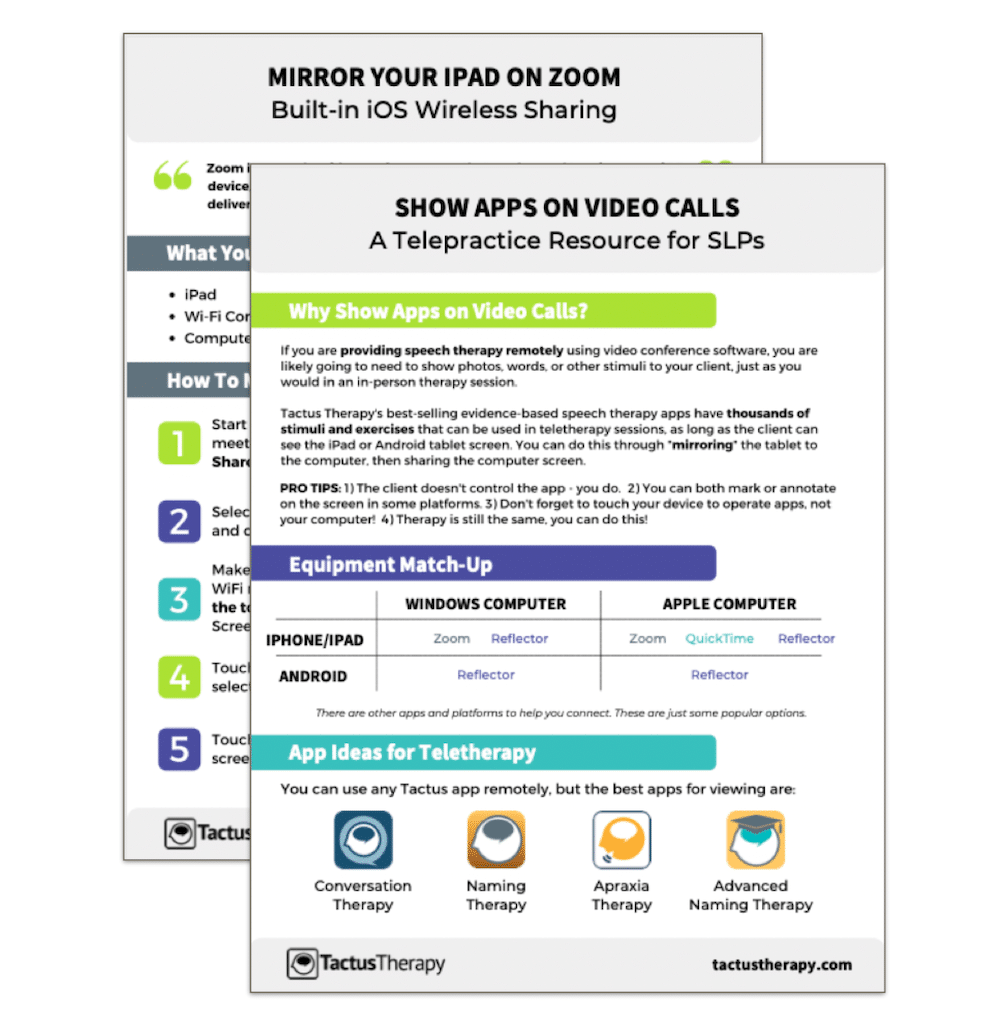Telepractice Brings Aphasia Therapy to Your Home
6 min read
As technology advances, more opportunities become available to people recovering from aphasia. Online support groups and apps for tablets can bring recovery support right into to your living room. Another option that is still relatively new, but growing rapidly, is telepractice.
What is Telepractice?
Telepractice is a 1:1 speech therapy session with an SLP (speech-language pathologist) who happens to be in another room – perhaps in another city, a different state, or even across the country. Telepractice uses technology to bring a speech therapist to you.

In telepractice, even though you are not in the same room, you still:
- See the clinician and the clinician sees you. You use a webcam to see each other.
- Hear the clinician and the clinician hears you. Both people have speakers and a microphone. (I prefer wearing a microphone headset as it helps me hear and focus on the person I’m working with.)
- Interact. Most clinicians use software with a whiteboard so you can both write, draw, and work on the same visuals. You can refer to the same handouts online, write on the same practice sheets and/or pictures, and even play games designed to address your therapy goals. Depending on the software, you can even screenshare apps!
At SpeechSpark, we often incorporate apps, like Advanced Naming Therapy from Tactus Therapy, to work on treatment tasks. A benefit of using apps during therapy is you can easily transition to using them for home practice between sessions. Home practice of skills between treatments is essential for any effective rehabilitation program.
Who is a Good Candidate for Telepractice?
Almost anyone can benefit from telepractice, but the only way to be sure it’s right for you is to give it a try. Talk with an SLP who is experienced and comfortable with telepractice. Some clients prefer to try a few sessions before committing to a series of treatments via telepractice. Considerations of a good candidate for telepractice include:
- Physically being able to access the computer
- You should be able to see and hear the computer. Sometimes moving the camera/computer position helps. Headphones and/or adjusting the volume can also help a person hear.
- You need to be able to control the keyboard and mouse.
- Attention and motivation
- Just like any speech therapy session, the client will benefit most when they are participating and putting maximum effort into their recovery.
- Access to technology
- You’ll need access to a computer with camera and headset (or microphone/speakers) in a quiet environment.
- Connect with a minimum speed of 384 Kbps. Websites like speedtest.net can help you determine your internet speed.
- It’s good to have a support person to help troubleshoot any glitches – just in case.

Is Telepractice Effective for Therapy?
Short answer: Yes!
Long answer: Over the past 10+ years, research has demonstrated that telepractice effectively treats a wide range of disorders including articulation, language, swallowing, fluency, voice, and aphasia. In 2014, a study assessed the effectiveness in telepractice treating chronic aphasia and found that average scores “improved on most measures following treatment, generally significantly. … Independent work increased with time, and user satisfaction following participation was high.”
The Informed SLP offers a free list of the evidence for teletherapy. Join using code “Tactus10” for $10 off any subscription.
What about Privacy?
Telepractitioners carefully choose their online platforms to ensure privacy. No one can enter a virtual treatment room without the clinician’s permission, and there will not be anyone else in the room with the clinician. If you have someone else with you, be sure to let the clinician know.
If your session is recorded, it will only be with your consent, and it is the clinician’s responsibility to store any recordings in a secure location. Recording can be beneficial if you want to review the video between sessions to refresh your memory on any techniques you learned during the session.
What Should I Look For in a Telepractice Clinician?
- Are they certified by ASHA or your national speech-language pathology organization?
- Are they licensed to practice within your state or province? SLPs should be licensed in both the jurisdiction where they live as well as where you live.
- Do they have experience/expertise in your diagnosis? The advantage of telepractice is that you aren’t limited to only the specialists in your area. If you have aphasia, you can find a clinician who specializes in aphasia recovery.
- Do they offer a pay-as-you-go option? This lets you try out telepractice for a few sessions to see if it is a good fit before making a large investment.
- As you try a few sessions, consider:
- Am I able to access the technology sufficiently?
- Do my SLP and I have good rapport? Are they able to answer my questions?
- Can I email my SLP between sessions with questions/comments/for support?
- Am I able to request copies of recordings so I can review what I learned?
What Else Should I Take into Consideration?
Convenience – You can complete your therapy session in your own home, eliminating travel time and uncomfortable clinics. In-home treatment can be more functional than clinic-based therapy too.
Specialized Treatment – You can access clinicians who specialize in your disorder, regardless of your geographic region. Not every SLP is an expert in aphasia, but you can find a telepractioner who is.
Payment – Telepractice is typically private pay only. Medicare does not currently cover speech therapy via telepractice, though that will likely change in the future. Some insurance programs do cover telepractice, particularly if there is no access to an SLP in your geographic area. You would need to call your insurance company to ask specifically about this option. As the technology is relatively new, some insurance representatives aren’t aware of what telepractice is, and obtaining coverage can be difficult. Telepractice services are typically less expensive than in-office or home health services because travel and other overhead expenses are reduced.
Internet connection – In some areas, it can be difficult to get an internet connection fast enough for telepractice. Internet connection delays can cause echoes or delayed sound. You can call your internet provider to explore speed options. You may need to spend some time before or during a session troubleshooting problems that come up. Your SLP and/or someone in your home can help with this. Typically you can connect and get started with just a few clicks. Depending on how interactive with the controls you choose to be, you can even use a tablet for some telepractice options. Once you find a telepractice clinician, spend a little time getting to know the software; it’s typically easier than you think.
Telepractice is one of the newest ways to bring quality therapy to more people. Even online, clinicians are able to use evidence-based techniques and strategies to help clients progress towards their goals. As technology continues to advance (and insurance catches up to fund these advances), telepractice will continue opening doors to provide support for aphasia recovery.
Learn more about telepractice at SpeechSpark, or see what the American Speech Language Hearing Association and Speech-Language and Audiology Canada have to say about telepractice.
Find the best apps for aphasia therapy, specific to your needs, using our free Aphasia App Finder wizard.


